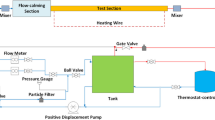Abstract
In this study the Stereoscopic Particle Image Velocimetry (S-PIV) technique was used to analyze the aerodynamic behavior of a textured surface. This textured surface is supposed to cover the inside of the hot wall of asymmetric heat exchangers. A high heat transfer coefficient and a low pressure drop are desired for the studied module receiver. The proposed textured geometry consists of an association of actuators (i.e., vortex generators) and riblets (used as vortex handlers). To determine the flow structure near the walls with good accuracy, an experiment was carried out in a large-scale boundary layer wind tunnel. The post-processing of the velocity fields obtained with the S-PIV technique allows us to obtain indicators of the pressure drop and of the heat transfer coefficient even if the stream is isothermal for these experiments. Nine riblet-actuator couples are studied and compared to the results obtained for an untextured surface. This work points out that the configuration including actuators and riblets of large dimensions is the best performing. This result is qualitatively validated by the analysis of the three components and two-dimensional averaged velocity fields.
Similar content being viewed by others
References
Kays, W.M., London, L.: Compact Heat Exchangers, 3rd ed. Hardcover (1984)
Schwarzbözl, P., Schmitz, M., Pitz-Paal, R., Buck, R.: Analysis of solar gas turbine systems with pressurized air receivers (Refos). In: Proceedings of 11th SolarPACES International Symposium on Concentrated Solar Power and Chemical Energy Technologies, Zürich, Switzerland (2002)
Godard, G., Stanislas, M.: Control of a decelerating boundary layer. Part 1: optimization of passive vortex generators. Aerosp. Sci. Technol. 10(3), 181–191 (2006)
IEA: Energy Technology Perspectives – Scenarios & Strategies to 2050 (2008)
Vrinat, M.: Contribution au développement d’un absorbeur surfacique à air pressurise haute température pour centrale solaire à concentration à tour. PhD thesis, University of Perpignan, Odeillo, France (2010)
Daguenet-Frick, X., Toutant, A., Fall, R., Bataille, F., Olalde, G.: Numerical analysis of high temperature pressurized-air solar receiver. In: 15th Solar Paces International Symposium, Berlin (2009)
Daguenet-Frick, X., Toutant, A., Segui, C., Bataille, F., Olalde, G.: Numerical investigation of an original concept of ceramic high temperature pressurized-air solar receiver. In: Proceedings of 16th Solar Paces International Symposium on Concentrated Solar Power and Chemical Energy Technologies, Perpignan, France (2010)
Jacobi, A.M., Shah, R.K.: Heat transfer surface enhancement through the use of longitudinal vortices: a review of recent progress. Exp. Therm. Fluid Sci. 11, 295–309 (1995)
Garimella, S.V., Eibeck, P.A.: Effect of spanwise spacing on the heat transfer from an array of protruding elements in forced convection. Int. J. Heat Mass Transfer 34(9), 2431–2433 (1991)
Lin, J.C.: Review of research on low-profile vortex generators to control boundary-layer separation. Prog. Aerosp. Sci. 38, 389–420 (2002)
Ashill, P.R., Fulker, J.L., Hackett, K.C.: Studies of flows induced by sub boundary layer vortexgenerator s (SBVGs). In: 40th AIAA Aerospace Sciences Meeting and Exhibit, Reno, NV, 14–17 Jan 2002
Yao, C.-S., Lin, J.C., Allan, B.G.: Flowfield measurement of device-induced embedded streamwise vortexon a flat plate. In: 1st AIAA Flow Control Conference, St. Louis, MO, 24–27 June 2002
Allan, B.G., Yao, C.-S., Lin, J.C.: Numerical simulation of vortexgenerator vanes and jets. In: 1st AIAA Flow Control Conference, St. Louis, MO, 24–27 June 2002
Viswanath, P.R. Aircraft viscous drag reduction using riblets. Prog. Aerosp. Sci. 38(6–7), 571–600 (2002)
Coustols, E.: Effet des parois rainurées (riblets) sur la structure d’une couche limite turbulente; Effect of grooved surfaces (riblets) on the structure of a turbulent boundary layer. Méc. Ind. 2(5), 421–434 (2001)
El-Samni, O.A., Yoon, H.S., Chun, H.H.: Turbulent flow over thin rectangular riblets. J Mech Sci Technol 19(9), 1801–1810 (2005)
El-Samni, O.A., Chun, H., Yoon, H.S.: Drag reduction of turbulent flow over thin rectangular riblets. Int. J. Eng. Sci. 45(2–8), 436–454 (2007)
Lee, S.J., Lee, S.H.: Flow Field Analysis of a Turbulent Boundary Layer Over a Riblet Surface, vol. 30(2), pp. 153–166. Springer (2001)
Garcia-Mayoral, R., Jiménez, J.: Drag reduction by riblets. Philos. Trans. R. Soc. 369, 1412–1427 (2011)
Salinas Vázquez, M., Vicente Rodríguez, W., Issa, R.: Effects of ridged walls on the heat transfer in a heated square duct. Int. J. Heat Mass Transfer 48(10), 2050–2063 (2005)
Olalde, G., Flamant, G., Daguenet, X., Toutant, A., Foucaut, J.M., Coudert, S.: Textured modular surface receptor operating at a high temperature. International Patent WO 2011/045301 A2 (2011)
Lessieur, M.: Turbulence in Fluids. Fourth Revised and Enlarged Edition. Springer, The Netherland (2008)
Clauser, F.H.: The turbulent boundary layer. Adv. Appl. Mech. 4, 1–51 (1956)
Van Driest, E.R.: On turbulent flow near a wall. J. Aerosp. Sci. 23, 1007–1011 (1956)
Carlier, J., Stanislas, M.: Experimental study of eddy structures in turbulent boundary layer using PIV. J. Fluid Mech. 535, 143–188 (2005)
Adrian, R.J.: Particle imaging techniques for experimental fluid mechanics. Annu. Rev. Fluid Mech. 23, 261–304 (1991)
Westerweel, J.: Fundamentals of digital particle image velocimetry. Meas. Sci. Technol. 8(12), 1379–1392 (1997)
Foucaut, J., Carlier, J., Stanislas, M.: PIV optimization for the study of turbulent flow using spectral analysis. Meas. Sci. Technol. 15, 1046–1058 (2004)
Willert, C.: Stereoscopic digital particle image velocimetry for applications in wind tunnel flows. Meas. Sci. Technol. 8, 1465–1479 (1997)
Soloff, S., Adrian, R.J., Liu, Z.C.: Distortion compensation for generalized stereoscopic particle image velocimetry. Meas. Sci. Technol. 8, 1441–1454 (1997)
Adrian, R.J.: Dynamic ranges of velocity and spatial resolution of particle image velocimetry. Meas. Sci. Technol. 8, 1393–1398 (1997)
Willert, C., Gharib, M.: Digital particle image velocimetry. Exp. Fluids 10, 181–193 (1991)
Coudert, S., et al.: Double large field stereoscopic piv in a high reynolds number turbulent boundary layer. Exp. Fluids 50, 65–73 (2009)
Coudert, S., Schon, J.P.: Back-projection algorithm with misalignement corrections for 2D3C stereoscopic PIV. Meas. Sci. Technol. 12, 1371–1381 (2001)
Author information
Authors and Affiliations
Corresponding author
Rights and permissions
About this article
Cite this article
Daguenet-Frick, X., Foucaut, JM., Coudert, S. et al. Experimental Analysis of the Turbulent Flow Behavior of a Textured Surface Proposed for Asymmetric Heat Exchangers. Flow Turbulence Combust 89, 149–169 (2012). https://doi.org/10.1007/s10494-012-9387-y
Received:
Accepted:
Published:
Issue Date:
DOI: https://doi.org/10.1007/s10494-012-9387-y




